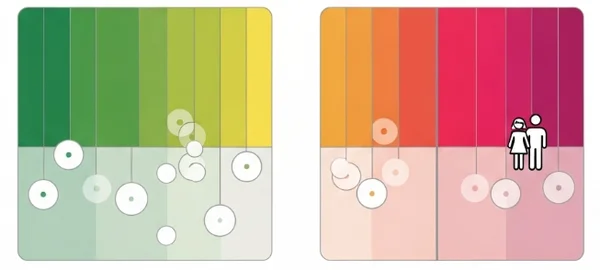The Asexual Spectrum: Understanding Asexuality & Aromanticism
Exploring the Ace Spectrum: Lack of Attraction & Diverse Identities
The beautiful diversity of human sexual orientation includes a wide range of experiences, and not everyone feels sexual or romantic attraction in the same way—or at all. If you've ever wondered, what is asexuality? or perhaps encountered terms like aromanticism and the asexual spectrum (often called the ace spectrum), this guide is for you. We'll delve into asexuality explained, explore the concept of lack of sexual attraction and lack of romantic attraction, and discuss the diverse identities within these spectrums. Understanding these often-misunderstood orientations is vital, and tools for self-reflection, like those at GayQuiz.org, can be part of your journey.
What is Asexuality? Defining a Lack of Sexual Attraction
Let's start by clearly defining asexuality. What is asexuality? Asexuality, at its core, describes a sexual orientation characterized by a persistent lack of sexual attraction towards any gender. An asexual person (often called "ace") generally does not experience sexual desire or an intrinsic pull towards others in a sexual way.

Understanding the "A" in LGBTQIA+
Within the broader LGBTQIA+ acronym, the "A" often stands for asexual, aromantic, and agender individuals. Recognizing asexuality as part of this queer spectrum is crucial for visibility and inclusion. The ace community is a vibrant part of this larger tapestry.
Asexuality is a Sexual Orientation, Not a Disorder or Choice
It's vital to understand that asexuality is a valid identity and a legitimate sexual orientation. It is not a disorder, a medical condition, a phase, or a choice like celibacy. It's about an innate lack of, or very low interest in, sexual activity driven by attraction. This distinction helps in debunking myths surrounding asexuality.
Introducing Aromanticism: Lack of Romantic Attraction
Distinct from, though sometimes co-occurring with, asexuality is aromanticism. What does aromantic mean? Aromanticism describes a romantic orientation characterized by little or no romantic attraction to others. An aromantic person (often called "aro") generally does not experience romantic feelings or desires for romantic relationships.
Differentiating Romantic Orientation from Sexual Orientation
To understand both asexuality and aromanticism, it's helpful to be aware of the split attraction model (SAM). This model suggests that romantic orientation (who you are romantically attracted to) and sexual orientation (who you are sexually attracted to) can be separate and distinct. This means someone can be asexual but experience romantic attraction (e.g., an asexual homoromantic person) or be aromantic but experience sexual attraction (e.g., an aromantic bisexual person). There are many types of attraction beyond just sexual and romantic.

The Aro Spectrum: Variations in Romantic Interest
Just like asexuality, aromanticism exists on a spectrum, often referred to as the aro spectrum. This includes individuals who are fully aromantic, as well as those who may experience romantic attraction rarely, under specific circumstances, or with less intensity, such as demiromantic (experiencing romantic attraction only after a strong emotional bond) or greyromantic individuals.
Navigating the Asexual Spectrum (Ace Spectrum) and Its Diversity
The asexual spectrum (or ace spectrum) is broad and encompasses a range of experiences related to lack of sexual attraction or experiencing it in very specific ways. It's not a monolithic identity. If you're wondering "Am I asexual quiz?", understanding this diversity is important.
Demisexuality: Attraction After an Emotional Bond
Demisexuality is an identity on the asexual spectrum where an individual only experiences sexual attraction after forming a strong emotional bond with someone. Without this pre-existing connection, sexual attraction typically doesn't arise. This highlights that for some, attraction has specific conditions.
Greysexuality (Gray-A): Experiencing Attraction Infrequently or Mildly
Greysexuality (also known as Gray-asexuality or Gray-A) describes individuals who experience sexual attraction very infrequently, with very mild attraction intensity, or only under very specific and limited circumstances. They exist in the "grey area" between asexuality and allosexuality (experiencing sexual attraction more regularly).
Other Identities on the Ace/Aro Spectrums
The ace umbrella and aro umbrella are vast, including many other nuanced identities that people use to describe their unique experiences with sexual and romantic attraction (or lack thereof). The key is respecting personal experiences and self-identification.

Common Misconceptions About Asexuality and Aromanticism
Unfortunately, both asexuality and aromanticism are often met with common misconceptions. Debunking myths is crucial for fostering understanding and acceptance within the ace community and beyond.
"They Just Haven't Met the Right Person" - And Other Myths
One of the most pervasive and invalidating myths is that an asexual or aromantic person "just hasn't met the right person yet." This dismisses their valid identity and implies their orientation is temporary or a result of inexperience. Asexuality is an intrinsic orientation, not a waiting game.
Asexuality vs. Celibacy vs. Low Libido
It's important to distinguish asexuality explained from celibacy (a choice to abstain from sex) and low libido (which can be a medical condition or have various causes, but doesn't inherently mean a lack of attraction). Asexuality is about the attraction itself, not behavior or hormone levels.
Exploring if the Ace/Aro Spectrum Resonates with You
If you're reading about the asexual spectrum or aromanticism and finding that some aspects resonate with your personal experiences and feelings, further exploration might be helpful.
Reflecting on Your Own Experiences with Attraction
Consider your own history with different types of attraction. Do you often find yourself not experiencing sexual or romantic interest when others around you do? Do descriptions of the ace spectrum or aro spectrum feel more aligned with your inner world?
How a Sexuality Quiz Might (or Might Not) Help
While many online quizzes, including a general sexuality quiz or even a gay quiz from GayQuiz.org, focus primarily on the direction of attraction, the process of answering questions about your feelings can still offer some insights. However, a dedicated "asexual quiz" or one designed with the ace spectrum in mind would be more specific. Remember, these are tools for reflection, not diagnosis.

Finding Community and Understanding on the Asexual & Aromantic Spectrum
For individuals who identify on the asexual spectrum or aromantic spectrum, finding community and understanding can be incredibly affirming. The ace community and aro community (often overlapping) offer spaces for connection and validation.
Understanding the asexual spectrum, including asexuality explained and aromanticism, is crucial for recognizing the full diversity of human sexual orientation and romantic experiences. It's about acknowledging that a lack of sexual attraction or romantic attraction is a valid identity, not a disorder or something to be "fixed." Whether you identify on the ace spectrum or aro spectrum, or are simply learning, fostering respect and understanding benefits everyone. If you're exploring these aspects of yourself, remember that GayQuiz.org offers tools for self-reflection. What are your thoughts or questions about the ace/aro spectrum? We welcome respectful discussion in the comments.
Your Questions About Asexuality and Aromanticism Answered
Here are some common questions to further clarify asexuality explained and aromanticism:
-
Can an asexual person still have relationships?
Yes, absolutely! Asexual people can and do have fulfilling relationships of many kinds, including romantic ones (if they are not aromantic), queerplatonic relationships (QPRs), or deep friendships. Asexuality relates to sexual attraction, not the capacity for love or commitment.
-
Is it possible to be asexual and aromantic at the same time?
Yes. Someone who is both asexual (experiences little to no sexual attraction) and aromantic (experiences little to no romantic attraction) is often referred to as AROACE. This is a common combination on the ace/aro spectrums.
-
What does "ace" mean in the LGBTQ+ community?
"Ace" is a common shorthand term used within the ace community and broader LGBTQIA+ spaces to refer to asexual individuals or the asexual spectrum as a whole. Similarly, "aro" is used for aromantic.
-
Are there resources specifically for 3people on the asexual or aromantic spectrum?
Yes, organizations like AVEN (Asexual Visibility and Education Network) are excellent resources. Many online forums and social media groups also provide community and support for people identifying on the ace spectrum or aro spectrum.
-
How can I tell if I'm asexual or just experiencing a low sex drive?
Asexuality is about a lack of attraction, while low sex drive (libido) is about a lack of desire for sexual activity, which can have various causes (medical, stress, etc.) and doesn't necessarily mean a lack of attraction. An asexual person might have a libido but no interest in acting on it with others. If you're unsure, exploring resources or talking to an affirming professional might help. Considering an "asexual quiz" for reflection could be a starting point.